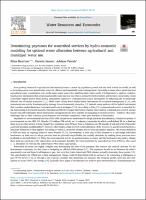Determining payments for watershed services by hydro-economic modeling for optimal water allocation between agricultural and municipal water use
Fecha
2019-04Palabras clave
Social Sciences - Environmental Science - Ecosystem service - Conservation - PES schemes - Modeling - Resource allocation - Water economics - Water use - WatershedColecciones
- Artículo científico [171]
Resumen
Evergrowingdemandforagriculturalandmunicipalwater,causedbypopulationgrowthandtheneedtofeedtheworld,aswellasincreasingstressoverwaterbodiescraveforefficientandsustainablewatermanagement.Especiallyinareaswheremunicipalandagriculturalwaterconsumptionrelyonthesamewatersourcesforsatisfyingtheirwaterneeds,itisimportanttoexploreevidence-basedpolicyinstrumentsthatachievesustainablewateruseinawaythatisoptimalforbothdwellersandfarmersconcurrently.Someeconomists regard market-based policy instruments superior to command-and-control instruments in enhancing the economicallyefficient use of natural resources [1,2]. While some clearly favor market-based instruments in ecosystem management [3,4], suchinstrumentsarenotthedominantpolicystrategyforenvironmentalprotection[5].Instead,manyauthorscallforhybridinstrumentsthatcombinemarket-basedandcommand-and-controlstrategies[5,6].AccordingtoVatn[7],command-and-controlisessentialforthefunctioningofecosystemmarkets.MuradianandRival[5]arguethathybridregimesthatcombinecommand-and-control,marketbasedtoolsandcommunity-basedinstitutionalarrangementsaremoresuitableinmanagingecosystemservices—whichsooftenraisechallengesduetotheircommongoodcharacterandintrinsiccomplexity—thanpuremarketsorhierarchies.
El ítem tiene asociados los siguientes ficheros de licencia:








